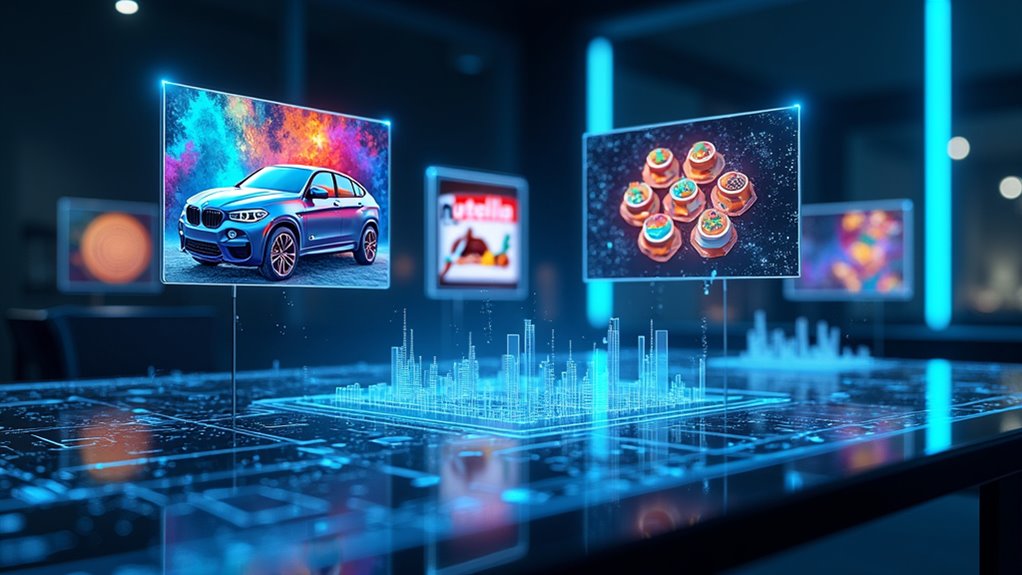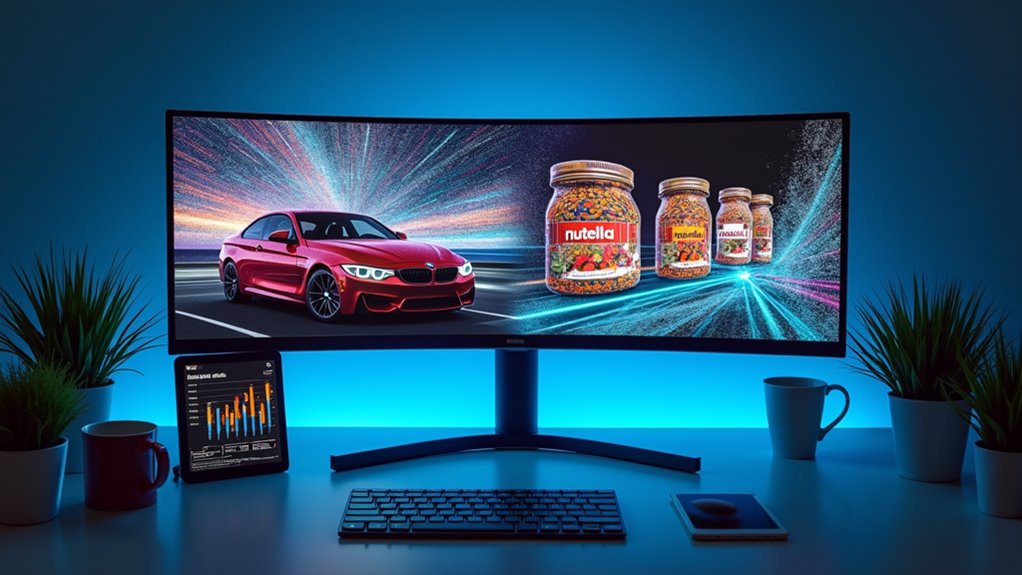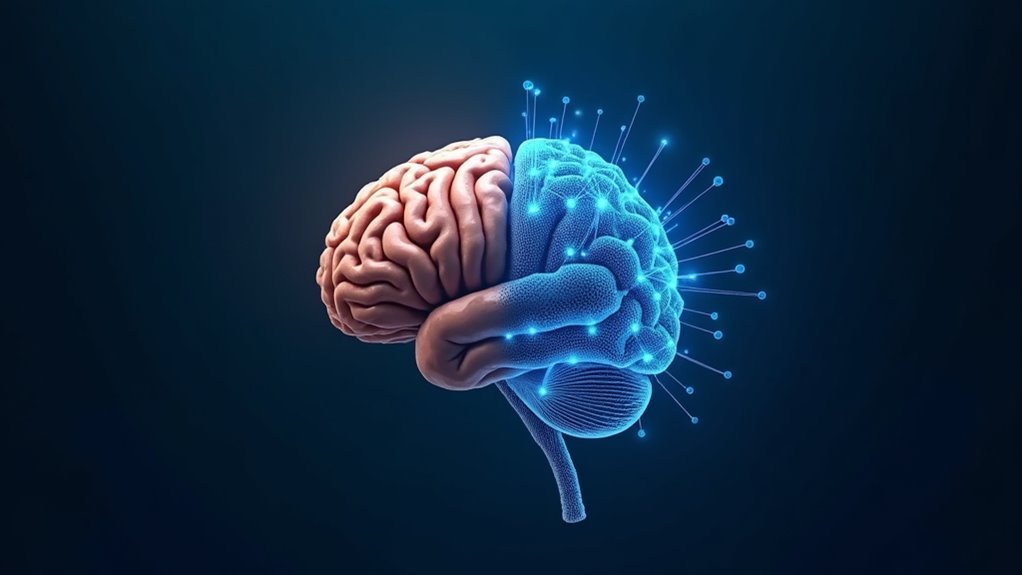Innovative AI advertising campaigns are revolutionizing how brands connect with consumers. BMW transformed vehicles into digital art, while Nutella’s “Unica” created seven million unique jar designs that became collectibles. Coca-Cola’s Create Real Magic platform lets consumers generate brand imagery, and Chase Bank saw a 450% increase in click-through rates with AI copy. Meta’s AI Sandbox enables personalized ad creation at scale. These campaigns don’t just look cool—they deliver measurable results through personalization and emotional storytelling. Discover what makes these AI strategies tick beyond their flashy exteriors.

While traditional marketing relied on human creativity alone, AI advertising campaigns are revolutionizing how brands connect with consumers. BMW demonstrated remarkable AI creativity by transforming its vehicles into digital masterpieces, blending art with technology to capture audience attention.
Campaign effectiveness soared when Nutella launched its “Unica” initiative, using AI to generate seven million unique jar designs—no two alike! This personalization strategy didn’t just look pretty; it dramatically boosted customer engagement and created collectible items consumers couldn’t resist.
Personalization isn’t just clever—it’s irresistible. Nutella’s AI-designed jars turned everyday products into must-have collectibles.
Nike took AI advertising to new heights with its Serena Williams campaign, pitting the tennis star’s past self against her present form. Talk about emotional connection! This ingenious approach celebrated Williams’ evolution while showcasing Nike’s innovative spirit.
Virgin Voyages didn’t fall behind, partnering with Jennifer Lopez for AI-generated cruise experiences that let potential travelers visualize their perfect vacation.
Want better ROI? Look at Chase Bank, which saw a staggering 450% increase in click-through rates using AI-generated ad copy. The Economist boosted subscriptions by 9% through AI-powered content personalization. These aren’t flukes—they’re the new marketing reality.
Programmatic advertising has become the backbone of AI marketing efforts. Meta’s AI Sandbox now helps advertisers create personalized ads with diverse images and backgrounds in seconds, not days.
Starbucks uses its Deep Brew AI to recommend orders to customers, making them feel understood and appreciated. The company leverages predictive analytics from app purchases to send personalized offers that increase average transaction values. Successful implementation requires a strategic approach that balances technological capabilities with ethical considerations around customer privacy. Brands must evolve or get left behind.
Coca-Cola partnered with OpenAI to create ad variations targeted to different demographics, while Heineken adjusted content in real-time based on audience feedback. Coca-Cola’s Create Real Magic platform allowed consumers to generate their own brand imagery using Chat GPT-4 and DALL-E technologies. Cadbury impressed millions with AI-generated videos featuring a Bollywood star mentioning specific store locations.
The most successful campaigns share a common thread: they use AI not just as a technological gimmick but as a tool for genuine personalization and connection.
Tomorrow Sleep proved this by using AI content tools to dramatically improve SEO, demonstrating that AI effectiveness extends beyond flashy campaigns to fundamental marketing strategies.
Frequently Asked Questions
What ROI Metrics Measure AI Advertising Campaign Success?
ROI metrics for AI advertising success include conversion rates (how many viewers actually buy), click-through rates (who’s bothering to click), and return on ad spend (ROAS).
Smart companies also track customer acquisition costs—because what’s the point of fancy AI if you’re spending a fortune per customer?
Time savings matter too; AI should reduce campaign management hours.
Don’t forget competitive advantage metrics—are you actually outperforming competitors with your shiny new AI tools?
How Much Does Implementing AI in Advertising Typically Cost?
Implementing AI in advertising typically costs between $20,000 and several hundred thousand dollars. The cost breakdown varies dramatically based on complexity and customization needs.
Budget considerations should include initial investment, data acquisition, and ongoing maintenance – not just software! Companies often underestimate integration costs with existing systems.
What Privacy Concerns Arise From Ai-Driven Personalized Advertising?
AI-driven personalized advertising raises significant privacy concerns. Companies collect vast amounts of personal data without proper user consent, creating potential data security risks.
This invasive tracking follows consumers across platforms, building eerily accurate profiles of their behaviors and preferences. While personalization can enhance user experience, it often crosses the line into surveillance.
Consumers should demand transparency about what’s collected and how it’s used. Remember, if a service is free, you’re probably the product.
Which AI Advertising Tools Work Best for Small Businesses?
Small businesses thrive with AI tools that maximize limited resources.
Madgicx excels for Meta advertising, automating ad management without breaking the bank.
Jasper and Copy.ai generate quick marketing content when you’re too busy wearing all those small business hats.
For e-commerce owners, Trellis optimizes campaigns while you sleep.
Remember, the best tool depends on your specific needs – don’t chase fancy features you’ll never use!
Start with solutions offering free trials and scalable pricing.
How Long Does It Take to See Results From AI Advertising?
AI campaign timelines vary, but businesses typically see initial results within weeks.
Want faster feedback? Focus on result tracking from day one. Simple campaigns yield quicker insights, while complex ones require patience.
Most advertisers notice meaningful improvements within 3-6 months—look for early CTR increases and conversion rate boosts as positive indicators.
Remember, your data quality directly impacts how quickly AI learns (garbage in, garbage out!).
Efficiency gains often appear before dramatic revenue increases, so track multiple metrics.









